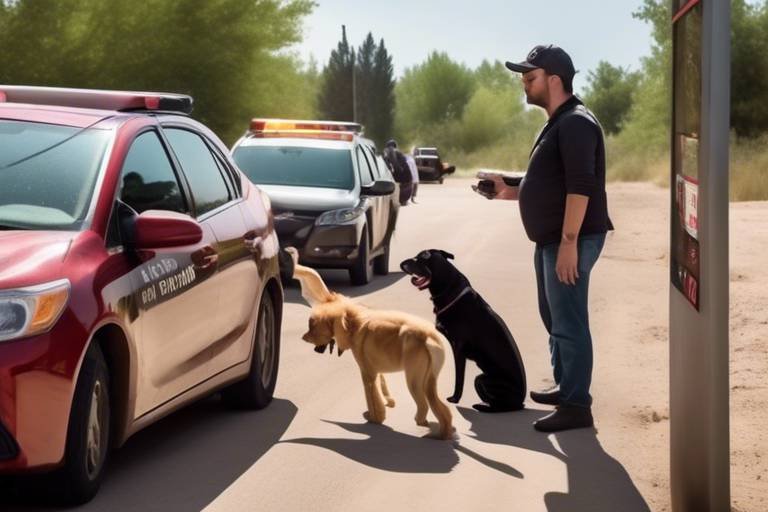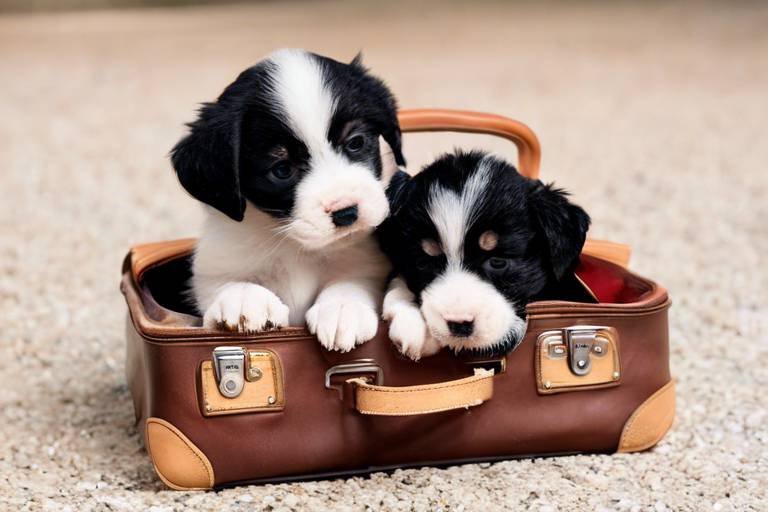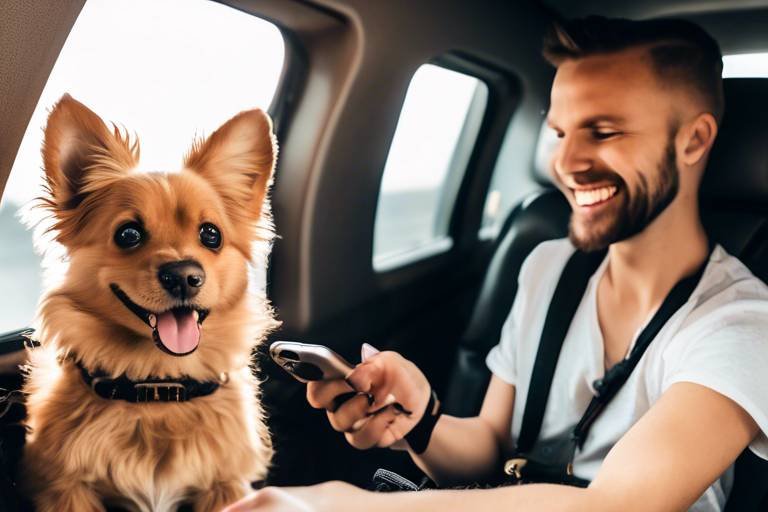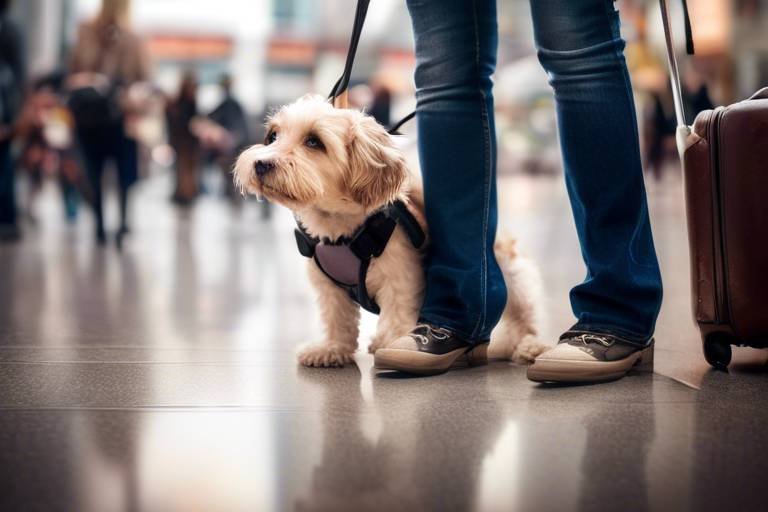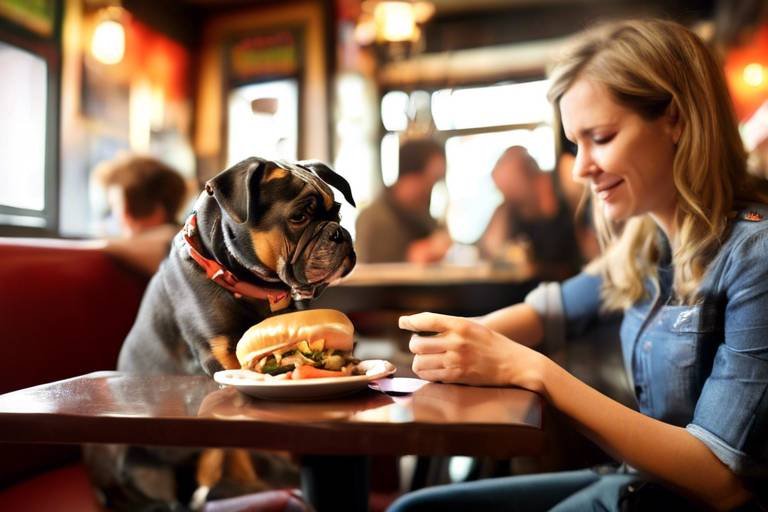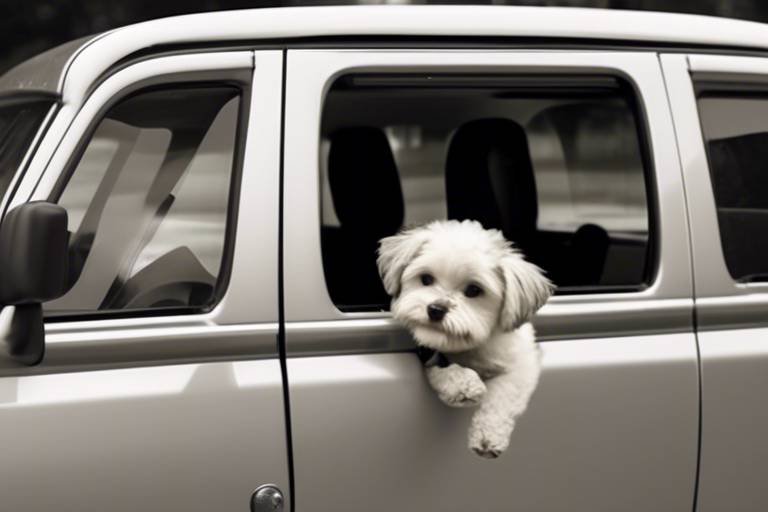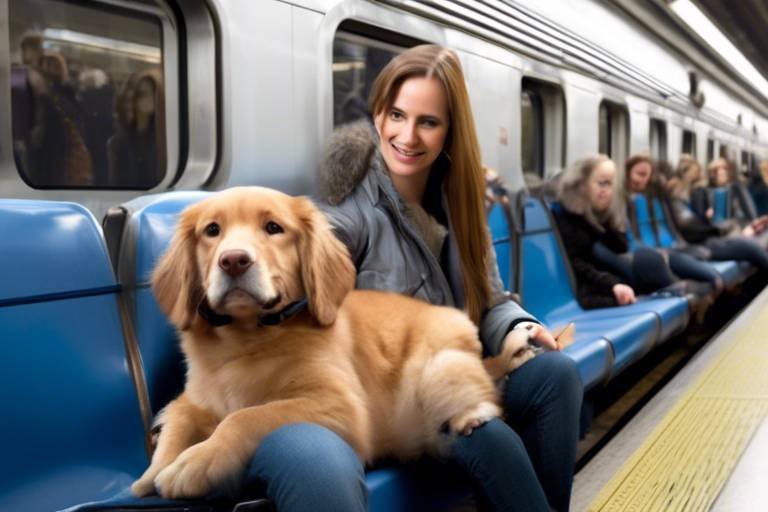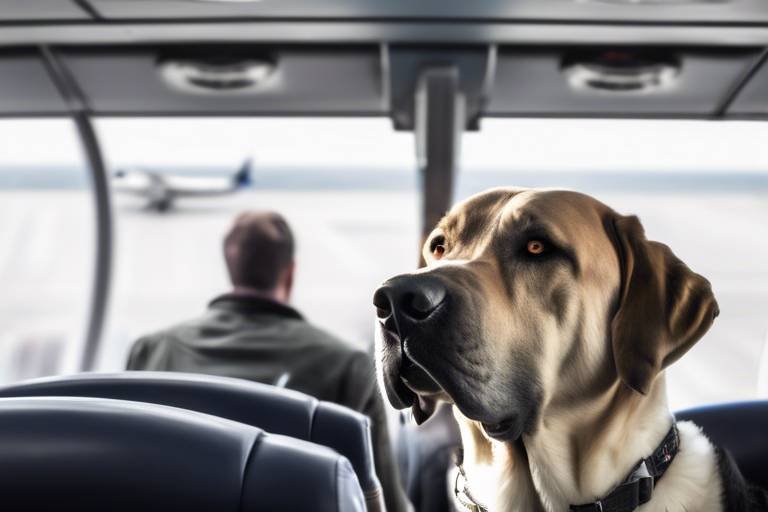Traveling with Pets - A Guide to Pet-Friendly Transport
Traveling with your furry friends can be one of the most rewarding experiences, but it also comes with its own set of challenges. If you've ever looked into the eyes of your pet while packing your bags, you've probably felt that twinge of guilt—shouldn’t they be part of the adventure too? The truth is, with a bit of planning and the right mindset, you can ensure a smooth and enjoyable journey for both you and your beloved companion. Whether you're hitting the road for a weekend getaway or jet-setting across the country, this guide will provide you with essential tips and information to navigate the world of pet-friendly transport.
When it comes to traveling with pets, the mode of transport you choose can greatly impact your experience. Each option has its pros and cons, and understanding them can help you make the best choice for your furry friend:
- Car: Traveling by car offers flexibility and control, allowing you to stop for breaks whenever your pet needs them. However, long hours can lead to restlessness, so it’s essential to plan for regular stops.
- Train: Trains can be a comfortable option for pets, often allowing them to sit with you. But, not all train services are pet-friendly, so checking policies in advance is crucial.
- Plane: Air travel is sometimes unavoidable, especially for long distances. While it can get you to your destination quickly, the stress of airport security and cabin conditions can be daunting for pets.
- Bus: Some bus services welcome pets, but space can be limited, and the travel duration can be long. Always check the specific pet policies of the bus company.
Preparation is key to a successful trip. Start by acclimating your pet to their travel environment. If you're going by car, take them on shorter rides to get them used to being in a vehicle. For air travel, consider visiting the airport with your pet to familiarize them with the sounds and smells. Additionally, don’t forget to schedule a health check with your vet to ensure your pet is fit for travel. Vaccinations and medications may be necessary, especially for long journeys.
Before embarking on your journey, it’s vital to ensure your pet is healthy and fit to travel. Make a checklist of health considerations:
- Check for up-to-date vaccinations.
- Discuss any medications your pet may need during travel.
- Schedule a vet check-up to assess your pet's health status.
Taking these steps not only ensures your pet's safety but also provides peace of mind for you as a pet owner.
Older pets may require special considerations. They often have specific health needs that must be addressed before and during travel. Ensure they have comfortable bedding, frequent breaks, and easy access to food and water. Keep an eye on their mobility and be prepared to assist them if they struggle with stairs or jumping in and out of vehicles.
Pets with disabilities or specific health issues may require additional support. This could include special carriers, mobility aids, or even a travel companion. Always consult with your vet to ensure you have the necessary accommodations for their comfort and safety. Remember, a little extra planning goes a long way in making your pet feel secure and happy during travel.
Safety should always be a priority when traveling with pets. Here are some essential safety measures to protect your furry friend:
- Use a pet seatbelt or carrier in the car.
- Keep your pet's identification tags updated.
- Prepare an emergency kit with food, water, and first-aid supplies.
By taking these precautions, you can help ensure that your journey is as safe as it is enjoyable.
Not all places welcome pets, which can make finding accommodations a challenge. Start your search by using pet-friendly travel websites or apps. Look for hotels or rentals that specifically advertise themselves as pet-friendly. When in doubt, call ahead to confirm their policies regarding pets, including any fees or restrictions.
Understanding hotel or rental policies regarding pets is crucial. Some places may have weight limits, while others might require a pet deposit. Always read the fine print and confirm any details before booking to avoid surprises upon arrival.
Pet-friendly accommodations may vary in amenities and rules. Some may offer pet beds and bowls, while others may simply allow your pet to stay with you. It's essential to know what to expect so you can prepare accordingly. Always be respectful of the property and keep your pet on a leash in common areas.
Being a responsible pet owner while traveling is essential. This means respecting others and maintaining good behavior with your pet in public spaces. Always clean up after your pet, keep them leashed, and be mindful of noise levels. A well-behaved pet reflects positively on you as an owner and makes the travel experience enjoyable for everyone.
Q: Can I take my pet on public transportation?
A: Many public transportation systems allow pets, but policies vary. Always check in advance.
Q: What should I pack for my pet?
A: Essentials include food, water, bowls, leash, waste bags, and any medications.
Q: How do I calm my pet during travel?
A: Consider using calming products or consult your vet for advice on anxiety-reducing options.

Choosing the Right Mode of Transport
When it comes to traveling with your furry friends, one of the most crucial decisions you'll face is . Each option—be it car, train, plane, or bus—comes with its own set of advantages and challenges. So, how do you decide what's best for you and your pet? Let's dive into the pros and cons of each to help you make an informed choice.
Traveling by car is often the most flexible option. You can stop whenever you need, whether it’s for bathroom breaks, food, or a little playtime to stretch those legs. Plus, your pet can enjoy the view from the backseat! However, long drives can be tiring, and not all pets are comfortable in a moving vehicle. It's essential to acclimate your pet to car rides gradually. A few short trips before your big journey can make a world of difference. Remember to keep your pet secured with a harness or in a pet carrier for their safety.
If you're considering train travel, it can be a delightful experience. Trains often have more space than planes, allowing your pet to move around a bit more. Many train services are pet-friendly, but it's vital to check the specific policies of the train company. Some may require pets to be in carriers, while others might allow them to roam freely. Just imagine your dog gazing out the window, taking in the scenery like a seasoned traveler! However, trains can be crowded, and loud noises may startle some pets, so be prepared to comfort them if needed.
Now, let's talk about flying. Air travel can be a mixed bag. On one hand, it gets you to your destination quickly, which is great for long distances. On the other hand, it can be stressful for pets. Many airlines have specific regulations regarding pet travel, including carrier dimensions and health documentation. It's crucial to book a direct flight if possible, as layovers can add unnecessary stress. If your pet is flying in the cargo hold, ensure they are comfortable and secure in their crate. Some airlines even offer special pet travel services, so don’t hesitate to ask for assistance!
Lastly, there’s bus travel. While it may not be the first option that comes to mind, some bus companies allow pets, making it an economical choice. However, space can be limited, and you might need to keep your pet in a carrier for the duration of the trip. It's a good idea to check the bus company's pet policy beforehand, as regulations can vary widely.
Here’s a quick comparison table to summarize the pros and cons:
| Transport Mode | Pros | Cons |
|---|---|---|
| Car | Flexible stops, comfortable | Long drives can be tiring |
| Train | More space, scenic views | Crowded conditions |
| Plane | Fast travel, long distances | Stressful, strict regulations |
| Bus | Economical, can allow pets | Limited space, carrier requirement |
In conclusion, the best mode of transport for you and your pet largely depends on your specific needs, the distance of your journey, and your pet's temperament. Remember, the goal is to make the travel experience as comfortable and enjoyable as possible for both you and your furry companion. So, weigh the options, consider your pet's personality, and get ready for an adventure together!

Preparing Your Pet for Travel
Traveling with your furry friend can be an exhilarating experience, but it requires careful preparation to ensure that both you and your pet have a smooth journey. Just like you wouldn't head out on a road trip without packing your essentials, your pet deserves the same consideration. Start by getting your pet used to the idea of travel. This might involve taking short car rides or visits to the vet to help them acclimate to being in a carrier or vehicle. Remember, the goal is to make them feel comfortable and secure during the entire journey.
Next, it's crucial to schedule a vet check-up before your trip. This ensures that your pet is healthy enough to travel and up-to-date on their vaccinations. Some destinations may require specific vaccinations, so it's wise to consult your vet about any health certificates you might need. Also, don’t forget to ask about any medications your pet might require during the trip, especially if they tend to get anxious or motion sick.
When it comes to health considerations, you should be aware of the following:
| Health Aspect | Details |
|---|---|
| Vaccinations | Ensure your pet is up-to-date on all vaccinations, especially rabies, which is often required for travel. |
| Medications | Consult your vet for any medications that might help with anxiety or motion sickness. |
| Health Certificates | Some destinations may require a health certificate from your vet, especially for air travel. |
For those traveling with older pets, special considerations are necessary. They may have unique health needs or mobility challenges that require extra attention. Make sure to bring along their favorite blanket or bed to provide a sense of familiarity, and schedule frequent breaks during your travels to allow them to stretch their legs and relieve themselves.
If you have a pet with special needs, it's essential to make accommodations ahead of time. This could mean packing specific supplies, such as mobility aids or special food, and ensuring that your travel plans include stops that cater to their needs. Always have a plan for emergencies—know where the nearest veterinary clinics are along your route.
Lastly, packing the right supplies can make all the difference. Here’s a quick checklist of what to bring:
- Food and water
- Bowls
- Leash and harness
- Waste bags
- Comfort items (toys, blankets)
- First-aid kit
By taking these steps, you can ensure that your pet is well-prepared for the adventure ahead. Remember, a little preparation goes a long way in making your travel experience enjoyable for both you and your beloved companion.
Health Considerations
Before you hit the road or take to the skies with your beloved furry friend, it's crucial to ensure that they are in tip-top health. After all, a happy pet makes for a happy journey, right? Start by scheduling a visit to your veterinarian. This is not just a formality; it's an opportunity to discuss your travel plans and get a thorough health check-up for your pet. Make sure to ask about any vaccinations that might be necessary, especially if you’re traveling across state lines or internationally. Certain destinations may require specific vaccinations, so it’s better to be safe than sorry!
Additionally, don't forget to discuss any medications your pet may need during the trip. If your pet is on a regular medication, ensure you have enough to last the duration of your travels, plus a little extra just in case of delays. It’s a good idea to pack these medications in their original containers to avoid any confusion while on the go. You can even create a travel health kit for your pet, which might include:
- Medications
- First aid supplies
- Copies of vaccination records
- Favorite toys or comfort items
Now, let's talk about older pets. If your furry companion is a bit on the senior side, extra care is essential. Older pets may have health conditions that can be exacerbated by travel. Consider discussing with your vet whether your pet is fit for travel and what precautions you should take. For instance, older pets might need more frequent breaks during car trips or may benefit from a comfortable pet carrier that provides support for their joints.
For pets with special needs, the stakes are even higher. Those with disabilities or chronic health issues require tailored accommodations. Whether it’s a custom harness for a mobility-impaired pet or specific dietary needs, planning is key. You might even want to consult your vet for recommendations on how to manage your pet’s needs while traveling. Remember, the goal is to keep your pet as comfortable and happy as possible.
Finally, as you prepare for your trip, consider how travel can impact your pet's stress levels. Some pets are naturally anxious, and the hustle and bustle of travel can elevate their stress. To mitigate this, you might want to explore calming products, such as anxiety wraps or pheromone diffusers, which can help create a soothing environment during your journey.
Q: What vaccinations does my pet need before traveling?
A: The vaccinations required can vary by destination. It's best to consult your veterinarian to ensure your pet is up-to-date and meets any specific travel requirements.
Q: How can I help my anxious pet during travel?
A: Consider using calming products, providing familiar toys, and taking regular breaks during the journey to help ease their anxiety.
Q: Should I bring my pet's medical records?
A: Yes, bringing copies of your pet's medical records, including vaccination history and any medications, is highly recommended for emergencies or if you need to visit a vet during your trip.
Traveling with Older Pets
Traveling with older pets can be a rewarding experience, but it also comes with its own set of challenges. Just like us, our furry friends may face mobility issues, health concerns, and increased anxiety during travel. To ensure a smooth journey for your senior companion, it's essential to take a few extra steps in preparation. Think of it as planning a road trip with your favorite grandparent; you want to make sure they are comfortable, entertained, and safe throughout the journey!
First and foremost, a visit to the veterinarian is crucial. Before you hit the road, schedule a check-up to ensure your pet is in good health. Discuss any specific concerns you may have, such as their ability to handle long trips, and ask about any medications they might need during travel. This is also the perfect time to ensure that all vaccinations are up to date, as some accommodations or travel methods may require proof of vaccination.
Next, consider your pet's comfort during the journey. Older pets may need more breaks, so plan your route with plenty of stops to allow them to stretch their legs and relieve themselves. If you're traveling by car, invest in a comfortable pet seat cover and consider using a pet harness or crate for safety. Just like we buckle up for safety, our pets need to be secure too! If you're flying, check with the airline for their specific requirements for older animals, as they may have additional guidelines.
Another consideration is your pet's dietary needs. Stick to their regular feeding schedule as much as possible, and bring along their favorite food and treats. Sudden changes in diet can upset their stomachs, which is the last thing you want while traveling. Also, don't forget to pack plenty of water to keep them hydrated, especially if you're traveling to warmer climates.
Lastly, be prepared for any unexpected situations. Older pets may be more susceptible to stress, so bring along familiar items, such as their favorite blanket or toy, to help ease their anxiety. If your pet has specific medical needs, have a list of their medications and dosages handy, and research veterinary clinics along your route in case of emergencies. Think of it as packing a little "pet first aid kit" to ensure you have everything you need at your fingertips!
In summary, traveling with older pets requires a little extra love and attention, but with the right preparations, it can be a delightful experience. Remember, your furry friend is counting on you to make their journey as enjoyable as possible. After all, they may not be able to tell you how they feel, but their wagging tails and happy barks will say it all!
- What should I pack for my older pet when traveling? Be sure to pack their regular food, medications, water, bowls, a leash, and any comfort items like blankets or toys.
- How often should I take breaks during a road trip with my senior pet? Plan to stop every 2-3 hours to let your pet stretch, relieve themselves, and hydrate.
- Are there any airlines that cater specifically to older pets? Many airlines have specific guidelines for traveling with pets. Always check with the airline beforehand to understand their policies regarding older animals.
- What if my pet has a medical emergency while traveling? Research veterinary clinics along your route and keep a list of your pet's medications and health history for quick reference.
Traveling with Special Needs Pets
Traveling with special needs pets can be a rewarding yet challenging experience. These beloved companions often require extra attention and care, making planning essential for a smooth journey. Whether your pet has mobility issues, sensory sensitivities, or requires specific medical care, understanding their unique needs will help ensure their comfort and safety during travel.
First and foremost, it's crucial to consult with your veterinarian before embarking on any trip. They can provide tailored advice based on your pet's condition, including any necessary medications or adjustments to their routine. For instance, if your pet is on medication, you’ll want to ensure you have enough for the entire trip, plus a little extra in case of delays. Additionally, consider scheduling a check-up to confirm that your pet is healthy enough to travel.
When it comes to transportation, choose a mode that minimizes stress for your pet. For example, if your pet has difficulty with loud noises or crowds, traveling by car might be the best option. If you must fly, look for airlines that offer special accommodations for pets with disabilities, such as extra space or quieter areas. Always check ahead to understand the airline's policies and procedures regarding special needs pets.
It’s also important to prepare your pet for travel. Gradually acclimate them to their carrier or travel crate by allowing them to explore it at home. You might consider placing their favorite blanket or toy inside to create a sense of familiarity. This can help reduce anxiety and make them feel more secure during the journey.
During the trip, keep an eye on your pet’s behavior. If they seem stressed or uncomfortable, take breaks as needed. This is especially important for pets with mobility issues. Plan your stops ahead of time, ensuring you have access to pet-friendly areas where your furry friend can stretch their legs and relieve themselves.
Lastly, consider packing a travel kit specifically designed for your special needs pet. This kit might include:
- Medications and a copy of their medical records
- Comfort items like toys or blankets
- Portable water and food bowls
- Specialized harnesses or supports if needed
By taking these steps, you can create a travel experience that is not only enjoyable but also safe and comfortable for your special needs pet. Remember, the journey is just as important as the destination, and with a little extra planning, you can ensure that both you and your furry friend have a fantastic adventure together.
Q: What should I do if my pet has a medical emergency while traveling?
A: Always keep a list of local veterinarians or emergency animal clinics handy. Research these locations before your trip, and make sure you know how to get there in case of an emergency.
Q: Can I bring my special needs pet on public transportation?
A: Many public transportation systems allow pets, but policies vary. Check with the specific transportation authority for their rules regarding special needs animals.
Q: How can I help my pet feel comfortable during long trips?
A: Regular breaks, familiar items, and maintaining a calm demeanor can all help your pet feel more at ease. Consider using calming aids if your pet is prone to anxiety.
Safety Tips for Traveling
Traveling with your beloved pet can be an exhilarating experience, but it also comes with its own set of challenges. Ensuring your furry friend’s safety during the journey is paramount. First and foremost, consider investing in a quality pet carrier that complies with airline regulations if you’re flying. This is not just a fashionable accessory; it’s a secure haven for your pet, providing them with a sense of comfort and safety amidst the hustle and bustle of travel. Make sure the carrier is well-ventilated and spacious enough for your pet to stand, turn around, and lie down comfortably.
When traveling by car, always remember to secure your pet with a safety harness or in a crate. Just like humans wear seatbelts for protection, pets need to be restrained to prevent injury in case of sudden stops or accidents. A pet that roams freely in a moving vehicle can be a distraction, leading to dangerous situations. Furthermore, never leave your pet alone in a parked car, especially in extreme weather conditions. The temperature inside a vehicle can rise rapidly, leading to heatstroke or hypothermia.
Another critical aspect is to keep your pet’s identification up to date. Ensure they wear a collar with an ID tag that includes your contact information. Microchipping your pet is also a wise decision, as it increases the chances of a safe reunion should they get lost. It’s better to be safe than sorry, right? As a precaution, carry a recent photo of your pet, which can be invaluable if you need to post lost pet flyers or share on social media.
Before heading out, consult your veterinarian about any health concerns your pet might have, especially if you’re traveling long distances or to a new environment. It’s also a good idea to pack a travel kit for your pet. This kit should include their favorite food, water, bowls, medications, and a few toys to keep them entertained. Familiar items can help reduce anxiety during the trip. Additionally, make sure to include a first aid kit tailored for pets, which can be a lifesaver in emergencies.
Lastly, be prepared for the unexpected. Just as you would have an emergency plan for yourself, create one for your pet. Research nearby veterinary clinics at your travel destination and keep their contact information handy. This way, if anything goes awry, you’ll know exactly where to turn for help.
- What should I do if my pet gets anxious while traveling? - Try to keep their routine as normal as possible, and consider using calming products such as pheromone sprays or anxiety wraps.
- Can I take my pet on public transportation? - Many public transport systems have specific pet policies. Always check in advance to know the rules and regulations.
- What items should I include in my pet's travel kit? - Essential items include food, water, bowls, medications, a leash, waste bags, and a first aid kit.
- How can I help my pet adjust to traveling? - Gradually acclimate your pet to their carrier or car by taking short trips before embarking on a longer journey.

Finding Pet-Friendly Accommodations
Traveling with your furry friend can be an exhilarating experience, but finding the right place to stay can sometimes feel like searching for a needle in a haystack. Not all accommodations are created equal when it comes to welcoming pets, so it’s essential to do your homework before you pack your bags. Imagine pulling up to a beautiful hotel only to find out they don’t allow pets—what a bummer! To avoid such disappointments, let’s dive into some strategies to find the perfect pet-friendly accommodations.
First and foremost, the internet is your best friend. Websites like BringFido and PetsWelcome are treasure troves of information, featuring listings of hotels, motels, and even vacation rentals that roll out the red carpet for your four-legged companions. These platforms often include user reviews, which can provide insight into the actual pet-friendliness of a place. You wouldn’t want to end up in a so-called pet-friendly hotel that has a strict weight limit or charges exorbitant fees!
When searching for accommodations, pay close attention to the pet policies of each location. Some places may allow pets but have specific restrictions, such as size or breed limitations. Be sure to inquire about:
- Pet fees and deposits
- Size and breed restrictions
- Available amenities for pets (like dog parks or pet beds)
- Nearby pet-friendly attractions
Another critical factor to consider is the location of your accommodation. You’ll want to choose a place that’s not just pet-friendly but also conveniently located near parks, walking trails, or pet-friendly beaches. This way, your pet can stretch their legs and enjoy the great outdoors without too much hassle. Think of it like this: just as you wouldn’t want to be cooped up in a hotel room all day, your pet deserves the chance to explore and enjoy their surroundings too!
Booking in advance can also be a game-changer. Pet-friendly rooms can fill up quickly, especially during peak travel seasons. By securing your accommodation early, you can ensure that you get a spot that meets both your and your pet's needs. Plus, it gives you more time to plan your itinerary and find fun activities to do together!
Lastly, don’t forget to read the fine print! Before finalizing your booking, double-check the terms and conditions regarding pets. Some places might have hidden fees or specific rules that could affect your stay. For example, are pets allowed on furniture? Can you leave them unattended in the room? Knowing these details can help you avoid any surprises and ensure a smooth stay.
In summary, finding pet-friendly accommodations requires a bit of effort, but the reward is well worth it. By utilizing the right resources, understanding pet policies, and planning ahead, you can create a delightful travel experience for both you and your furry friend. After all, the journey is just as important as the destination!
| Question | Answer |
|---|---|
| Are all hotels pet-friendly? | No, not all hotels allow pets. It's essential to check their pet policy before booking. |
| Can I leave my pet alone in the room? | Policies vary by hotel. Some allow it, while others do not. Always check in advance. |
| Are there extra fees for bringing a pet? | Many accommodations charge a pet fee or deposit, so confirm this before your stay. |
| What amenities should I look for? | Look for pet-friendly amenities like dog parks, pet beds, and nearby walking trails. |
Researching Pet Policies
When it comes to traveling with your furry friend, one of the most crucial steps is of your chosen accommodations. Not all hotels, motels, or vacation rentals are created equal when it comes to welcoming pets. The last thing you want is to arrive at your destination only to find that your beloved companion is not allowed to stay. So, how do you ensure that you’re making the right choice?
First and foremost, it’s essential to read the fine print. Many establishments have specific rules regarding pet sizes, breeds, and even the number of pets allowed. For instance, some places might only accept small dogs or cats, while others may have restrictions on certain breeds due to insurance policies. It’s always a good idea to check if there are any additional fees for bringing your pet along. Some hotels charge a one-time pet fee, while others may have a daily rate. This can significantly affect your travel budget.
Another important aspect is understanding the amenities available for pets. Some pet-friendly accommodations go above and beyond, offering special services such as dog parks, pet beds, and even pet-sitting services. On the other hand, some may only allow pets without providing any additional facilities. It’s wise to ask about these amenities when making your reservation. You might want to know:
- Are there designated pet areas?
- Is there a weight limit for pets?
- Are pets allowed in all areas of the property?
- Is there a pet policy available online?
Additionally, consider reaching out directly to the accommodation. A quick phone call can provide clarity on any vague policies and help you gauge their attitude towards pets. This personal touch can often lead to better arrangements or accommodations for your pet's needs. Plus, you may discover that some places are more flexible than their online policies suggest.
Lastly, don’t forget to check reviews from other pet owners. Websites like TripAdvisor or Yelp often have sections where travelers share their experiences with pets. Look for comments about the pet-friendliness of the property, including how well the staff treated guests with pets. This can give you a clearer picture of what to expect and help you avoid any unpleasant surprises.
In summary, thorough research on pet policies is essential for a smooth travel experience. By understanding the rules, fees, and amenities related to pets, you can ensure that both you and your furry friend have a comfortable and enjoyable stay. Happy travels!
What to Expect at Pet-Friendly Locations
When you decide to travel with your furry friend, understanding what to expect at pet-friendly locations can make all the difference in your experience. It's like stepping into a new world where your pet is not just tolerated but welcomed with open arms! However, it’s essential to remember that pet-friendly doesn't always mean pet-perfect. Each location has its unique policies and amenities, so being prepared can help you and your pet enjoy your stay to the fullest.
First and foremost, you should anticipate some variation in pet policies. While many hotels and rentals boast pet-friendly status, the specifics can differ widely. Some places might allow pets of all sizes, while others may have strict weight limits or breed restrictions. It's crucial to check these details before making your reservation. A quick phone call or an email can save you from unexpected surprises upon arrival. Additionally, many establishments require a pet deposit or a cleaning fee, so it’s wise to budget for these potential costs.
Another aspect to consider is the amenities offered at pet-friendly locations. Many hotels provide pet beds, bowls, and even treats to ensure your furry companion feels right at home. Some might even have designated pet areas, such as parks or walking trails, making it easy for you to take your pet out for a stroll. However, not all places are created equal. For instance, a luxurious resort may offer a pet spa, while a budget motel may only provide a small patch of grass. Here’s a handy table to give you an idea of what you might find:
| Type of Accommodation | Common Amenities | Typical Restrictions |
|---|---|---|
| Luxury Hotels | Pet spas, gourmet pet menus, walking services | Weight limits, breed restrictions |
| Vacation Rentals | Fully fenced yards, pet beds, toys | Additional cleaning fees |
| Budget Motels | Basic pet supplies, outdoor areas | Size restrictions, limited amenities |
Moreover, while enjoying your stay, you might encounter other pet owners and their companions. This can be a great opportunity for socialization, both for you and your pet! However, it's essential to respect the space of others. Keep your pet leashed in common areas and ensure they are well-behaved, as not everyone may be as enthusiastic about pets as you are. Remember, a little consideration goes a long way in maintaining a harmonious environment for all guests.
Lastly, be prepared for the unexpected! Just like humans, pets can have their quirks and may react differently in new environments. You might find your pet is more anxious or excited than usual. Having familiar items, like their favorite blanket or toy, can help ease any anxiety. Also, don’t forget to keep an eye on your pet’s behavior and needs. After all, a happy pet makes for a happy trip!
- Are all hotels pet-friendly? - No, not all hotels allow pets. It's crucial to confirm their pet policy before booking.
- What should I bring for my pet when traveling? - Bring food, water, bowls, a leash, waste bags, and any comfort items like toys or blankets.
- Can my pet stay alone in the room? - Many places have policies regarding leaving pets unattended, so check with the accommodation first.
- What if my pet misbehaves during the stay? - Always keep your pet under control and be respectful to other guests. If issues arise, address them promptly.

Traveling Etiquette with Pets
Traveling with our furry friends can be one of the most rewarding experiences, but it also comes with a responsibility that shouldn't be overlooked. Just like we have our own travel manners, our pets also need to be well-behaved to ensure everyone has a pleasant experience. So, what does good traveling etiquette look like when you're accompanied by your four-legged companion? Let's dive into some essential tips that will not only keep your pet happy but also make you the kind of pet owner everyone admires.
First and foremost, it's crucial to recognize that not everyone is as enthusiastic about pets as we are. Some people may have allergies, fears, or simply prefer to avoid animals. Therefore, when in public spaces, always keep your pet on a leash. This not only ensures their safety but also gives others a sense of security. Imagine walking through a park and encountering a dog running freely; it can be both exciting and terrifying! A leash keeps your pet close and under control, making the environment more comfortable for everyone.
Another important aspect of traveling etiquette is cleanliness. Just like we wouldn’t leave our trash behind, we should also be diligent about cleaning up after our pets. Carry waste bags with you at all times, and make it a habit to pick up after your pet immediately. Not only is this considerate, but it also sets a great example for other pet owners. If everyone did their part, public spaces would be much more enjoyable for both pets and people!
When staying at pet-friendly accommodations, it’s essential to respect the property and its rules. Each place may have different guidelines regarding pets, so be sure to read the fine print before booking. For instance, some hotels might require pets to be crated when left alone in the room, while others may have designated pet areas. Being aware of these details can prevent misunderstandings and ensure a stress-free stay for both you and your pet.
Moreover, when dining out, always check if the restaurant has a pet-friendly policy. Many places offer outdoor seating where pets are welcome, but it’s best to ask first. If you’re lucky enough to find a spot that allows pets, keep your furry friend calm and well-behaved. Bringing along a favorite toy or a comfortable blanket can help your pet feel more at ease in a new environment. Remember, a well-behaved pet can make dining out a delightful experience for everyone!
Lastly, always be mindful of your pet's behavior. If your pet tends to bark excessively or show signs of anxiety, consider whether traveling is the best option for them. Some pets thrive on adventure, while others may prefer the comfort of home. If your pet is more of a homebody, it might be kinder to leave them with a trusted friend or family member while you embark on your journey.
In summary, practicing good traveling etiquette with pets is about being considerate, respectful, and prepared. By keeping your pet leashed, cleaning up after them, respecting accommodations, and being mindful of their comfort, you can ensure that everyone enjoys the journey. After all, traveling should be a joyful experience for both you and your beloved companion!
- What should I do if my pet misbehaves in public? - If your pet starts to act out, calmly remove them from the situation. Take a moment to regroup and, if necessary, find a quiet spot to help them settle down.
- Are there specific breeds that are better for travel? - While any pet can travel, smaller breeds or those with calmer temperaments often adapt better to new environments.
- How can I prepare my pet for travel? - Gradually acclimate your pet to their carrier or vehicle, take short trips, and ensure they are comfortable with the travel method you’ll be using.
Frequently Asked Questions
- What is the best mode of transport for traveling with pets?
The best mode of transport really depends on your pet's temperament and needs. Cars offer flexibility and comfort, while trains can be spacious and relaxing. Planes are faster but come with strict regulations, and buses can be a bit cramped. Always consider your pet’s personality and health when choosing!
- How can I prepare my pet for travel?
Preparation is key! Start by getting your pet accustomed to their carrier or travel crate. Take them on short car rides to help them adjust. Don’t forget to pack essentials like food, water, toys, and any medications they may need. A visit to the vet for a health check is also a smart move!
- What health considerations should I keep in mind?
Before hitting the road, ensure your pet is up-to-date on vaccinations and has any necessary medications. Older pets or those with special needs may require additional care, so consult your vet for tailored advice. Keeping your furry friend healthy is paramount for a stress-free trip!
- Are there special tips for traveling with older or special needs pets?
Absolutely! For older pets, ensure they have comfortable bedding and frequent breaks to stretch their legs. For pets with disabilities, consider their unique needs, like extra support or a quieter environment. Always prioritize their comfort and safety during the journey!
- How can I ensure my pet's safety while traveling?
Safety is a must! Use a secure carrier or harness to keep your pet safe in the vehicle. Always buckle them in, and never let them stick their heads out of the window. Having a pet first-aid kit handy can also be a lifesaver in emergencies!
- What should I look for in pet-friendly accommodations?
When searching for pet-friendly places, check their specific pet policies regarding size, breed restrictions, and additional fees. Look for amenities like pet beds, bowls, and nearby parks. Reading reviews from other pet owners can also give you great insights!
- What can I expect at pet-friendly locations?
Pet-friendly accommodations vary widely. Some may offer special treats or amenities for your furry friend, while others may have specific rules, like keeping pets on leashes. Always ask about their policies to avoid surprises!
- How should I behave with my pet in public spaces?
Being a responsible pet owner is crucial! Keep your pet leashed and under control, clean up after them, and be mindful of others. If your pet tends to bark or get anxious, consider using a muzzle or training them to stay calm in public settings.



